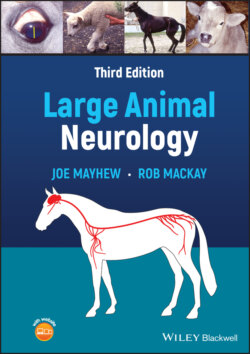Читать книгу Large Animal Neurology - Joe Mayhew - Страница 79
Neurons
ОглавлениеArtifactual changes in neurons are extremely common in microscopic specimens and are usually the result of fixation, sectioning, and staining procedures. Disappearance of neurons is good evidence of a lesion, but this is usually subjective. Neuronal changes, without associated glial or other cellular reactions, must be interpreted cautiously. Neuronal fiber (axon and myelin sheath) degeneration can be a useful sign of a neuronal defect even at a site distant from the cell body.
Swelling and shrinkage are two changes frequently seen in neurons and are reasonably reliable findings if they are present in well‐preserved tissue. Pale, basophilic swelling of the cytoplasm and nucleus is often the earliest observable change in infections, toxicities and hyperthermia, and it might be reversible. When there are excessive numbers of glial cells, notably microglia, surrounding such altered neurons, this is referred to as satellitosis. Where there is actual neuronophagia, then the change is irreversible. Shrinkage of a neuronal soma (cell body) is often seen in hyperthermia, hypoxia, and trauma. The process of shrinkage with loss of Nissl substance, eosinophilic homogenization or chromatolysis of the cytoplasm, and a shrunken, densely basophilic nucleus is referred to as ischemic neuronal cell change. It can be indicative of ischemia, hypoglycemia and other toxic and metabolic insults, and these cells are somewhat simplistically referred to as ischemic neurons. Simple atrophy of CNS neurons with axonal loss is part of the aging process. When chronic, trans‐synaptic atrophy occurs, and is present in many delayed onset, degenerative disorders, or abiotrophies. Neurofibrils in affected atrophic axons undergo shrinkage, hyperchromia, and beading.
Injury to neuronal processes can be divided functionally and morphologically into three stages. Neurapraxis is the state of loss of function only; axonotmesis is the severance of axons; and neurotmesis is the severance of the entire neuronal fiber, both axon and myelin sheath. In the PNS, degeneration and regeneration occur following interruption of axons. The nerve fiber that is distal to the site of damage disintegrates in 3–4 days, and more slowly the myelin degenerates as ellipsoids and droplets to be phagocytosed. The end plate, or receptor organ, atrophies and disintegrates, and Schwann cells begin proliferation. The nerve fiber proximal to the site of damage disintegrates minimally back toward the cell body, but the cell body shows a reactive change, including central chromatolysis and swelling with margination of the nucleus. Regeneration of several axonal stumps, with budding into proliferated Schwann cell membranes and endoneurial columns, begins within days, with further axonal growth at about 1–4 mm a day. Individual fiber replacement can be complete, but total quantitative nerve function is not. This degenerative and regenerative process was elegantly described in frog glossopharyngeal and hypoglossal nerves after axonotomy in a seminal paper24 by the British physiologist Augustus Volney Waller (1816–1870) at the age of 34 years. The overall pathologic process is referred to as Wallerian or Wallerian‐like degeneration and regeneration, and is now generally applied to injury to both peripheral and central axons due not only to trauma but also to inflammatory, immune‐mediated, and other mechanisms.25,26
In the CNS, Wallerian‐like degeneration occurs following focal axonal damage, but the regenerative process is markedly curtailed. The mapping of degenerated, distal neuronal fibers following damage is used to help define the site(s) of lesions in the CNS, particularly in the brainstem and spinal cord (see Figure 4.5 for a depiction of spinal cord histologic sectioning that can assist in mapping out the precise site of focal CNS lesions.). Thus, in a pathology report, if degeneration is only described in fibers in sensory (afferent) white matter pathways cranial to C6, and only in motor (efferent) fibers caudal to C6, then a focal lesion at C6 is most likely present. However, if afferent and efferent fiber degeneration is present in the T10 segment, there must be at least one lesion cranial to T10 and one lesion caudal to T10, or diffuse degeneration of neuronal fibers‐QED.
With many metabolic, toxic, and nutritional insults, axons may undergo degenerative changes that are often recognized as swelling. Such swollen axons, or spheroids, can be prominent in particular nuclear regions where neuroaxonal dystrophy is occurring. This process is common in some nutritional diseases and intoxications, and in certain hereditary disorders; it also occurs during the aging process.
Accumulation of pigments containing iron and calcium in and especially around neurons and blood vessels may indicate a previous influx of blood pigments to the area. Such pigmentations occur with aging, along with often spectacular intraneuronal accumulation of lipofuscin: the aging or wear and tear pigment. Accumulation of specific lysosomal products is the hallmark of the inherited lysosomal storage diseases as well as a few intoxications mimicking these enzyme deficiencies.
Axonal swellings (spheroids) and pigment accumulations (mainly lipofuscin) can be prominent in basal nuclear regions, the medulla oblongata, and intermediate zone of spinal gray matter of aged animals. Effete, or worn‐out, cells tend to accumulate at subependymal sites, particularly adjacent to the rostral ventricles. These changes are often accompanied by mineral and iron deposits near vessels in older patients making cautious histopathological interpretation necessary.
